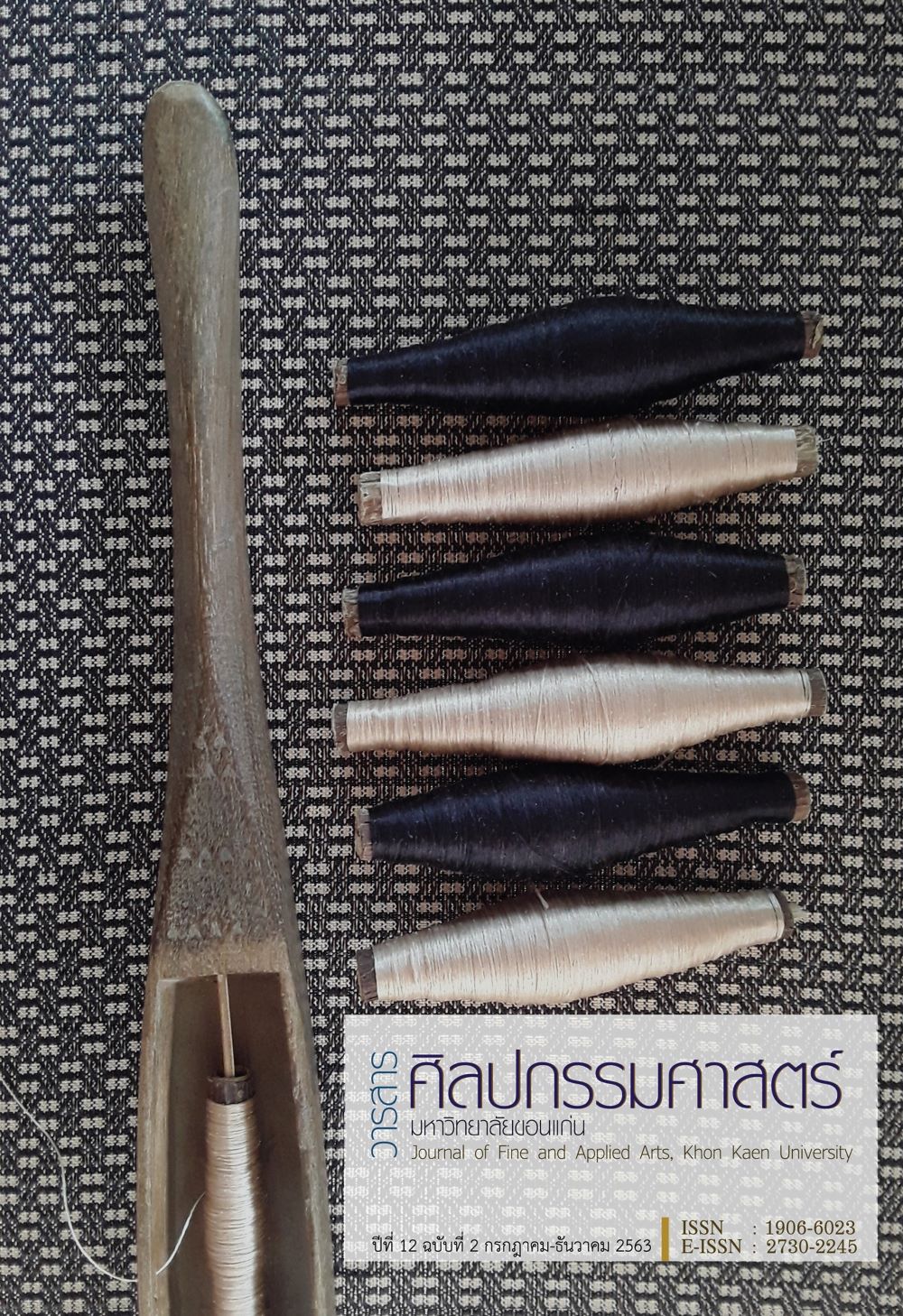Innovation of Development in the Hand Woven Cotton of the Local Identity in Loei Province.
Main Article Content
Abstract
The research of Innovation of development in the hand woven cotton of the local identity in Loei Province, purpose to study the innovation of hand woven cotton development in Loei province and to develop the innovation in hand woven cotton development in Loei province's local identity, as well as to evaluate the innovation process of hand woven cotton development in Loei province's local identity. The sample in this research is the population which is the group of community product manufacturers in Chiang Khan District. Loei consists of 8 sub-districts and the sample group is a group of hand-woven cotton manufacturers. In the research area and craftsmen, scholars and designers, by selecting a specific sample group in the development of innovation, the development of hand-woven cotton, local identity, Loei Province consists of Hand-woven cotton products of the community in Chiang Khan Subdistrict Hand-woven cotton products of the communities in That Sub-district Hand-woven cotton products in the community in Nasa Population and sample groups to assess the innovation development process, the development of hand-woven cotton, local identity, Loei Province The tools in this research are tools for data collection and analysis. It consists of the following tools In-depth interview Questionnaire, focus group and community product assessment (OPC)
Research result The research found that Innovation in hand-woven cotton development, provincial identity Is an increase in the value of hand-woven cotton products with innovation under the concept of using knowledge in Technology and innovation Together with creative design Blend culture local knowledge Identity of Loei Province In order to raise the level of hand-woven cotton products to have a contemporary international standard To increase the value of hand-woven cotton ceilings make a difference Enhancing the textile products with innovation to be the products that are needed in the wider market. So that the existing products expand the scope of trade and meet the needs of customers to increase Therefore, the development of products in the northeast woven fabric group will stimulate and encourage entrepreneurs to learn and access to new innovations and turn the crisis into more opportunities by thinking differently and producing work that meets the needs of the market. Will be able to further increase the sales value Build capacity and sustainability of local products, local products by adopting participatory learning processes with external agencies or government agencies participating in the development project. In which weaving members are involved in creating local identity weaving products in Loei Province to make the products more interesting In terms of designing and developing innovative hand-woven cotton, resulting in a unique production process by analyzing the problems that occur As well as organizing knowledge training activities by encouraging communities to participate, thereby resulting in product development and production processes, and from the development of local identity woven cloth products, Loei Province.
Article Details
Content and information in articles published in the Journal of Fine and Applied Arts of Khon Kaen University is regarded as the opinion and sole responsibility of the author(s) directly; therefore, editors are not obliged to agree to or share any responsibility with regard to the content and information that appears within these articles.
All articles, information, content, image, etc. that have been published in the Journal of Fine and Applied Arts of Khon Kaen University is the copyright of the Journal of Fine and Appllied Arts of Khon Kaen University. Any person or organization who wishes to distribute all or parts of the articles for further dissemination or other usage must first receive permission from the Journal of Fine and Applied Arts of Khon Kaen University before proceeding to do so.
References
กรมส่งเสริมอุตสาหกรรม กระทรวงอุตสาหกรรม. (2550). โครงการพัฒนาผลิตภัณฑ์และต้นแบบบรรจุภัณฑ์. กรุงเทพฯ : โอ.เอส.พริ้นติ้งเฮ้าส์.
คณะกรรมการอำนวยการหนึ่งตำบลหนึ่งผลิตภัณฑ์แห่งชาติ. (2549). แนวทางและหลักเกณฑ์การคัดสรรสุดยอด หนึ่งตำบล หนึ่งผลิตภัณฑ์ไทย ปี พ.ศ. 2549. กรุงเทพฯ : คณะกรรมการอำนวยการหนึ่งตำบลหนึ่งผลิตภัณฑ์แห่งชาติ.
จิรวัฒน์ พิระสันต์. (2543). ทฤษฎีและการวิจัยทางด้านศิลปะและการออกแบบ. พิษณุโลก : ภาควิชาศิลปะและการออกแบบ คณะสถาปัตยกรรมศาสตร์ มหาวิทยาลัยนเรศวร.
จิรวัฒน์ พิระสันต์. (2547). การพัฒนารูปแบบภารกิจของมหาวิทยาลัยในการพัฒนาศิลปกรรมท้องถิ่น: กรณีศึกษามหาวิทยาลัยนเรศวร. วิทยานิพนธ์ปริญญาดุษฎีบัณฑิต สาขาการบริหารการศึกษา บัณฑิตวิทยาลัย มหาวิทยาลัยนเรศวร.
จิรวัฒน์ พิระสันต์. (2552). ปฏิสัมพันธ์ของการเรียนรู้ศิลปกรรมท้องถิ่นในชุมชนและมหาวิทยาลัย. พิษณุโลก : คณะสถาปัตยกรรมศาสตร์ มหาวิทยาลัยนเรศวร
นิรัช สุดสังข์. (2548ก). การวิจัยการออกแบบผลิตภัณฑ์อุตสาหกรรม. กรุงเทพฯ : โอเดียนสโตร์.
นิรัช สุดสังข์. (2548ข). ออกแบบผลิตภัณฑ์อุตสาหกรรม. กรุงเทพฯ : โอเดียนสโตร์.
บูรชัย ศิริมหาสาคร. [ม.ป.ป.]. การทำ CoP เพื่อจัดการความรู้ในองค์กรโดยใช้เทคนิคการเล่าเรื่องความสำเร็จ. นครปฐม : สถาบันพัฒนาครู คณาจารย์ และบุคลากรทางการศึกษา (สคบศ.).
ประเสริฐ ศีลรัตนา. (2538). ของที่ระลึก. กรุงเทพฯ : โอ.เอส.พริ้นติ้งเฮ้าส์.
พัชรี เจริญเดช. [ม.ป.ป.]. การจัดการความรู้. กรุงเทพฯ : ศูนย์บริการสารสนเทศทางเทคโนโลยี.
พิชญ์ สมพอง. (2529). สังคมวิทยาว่าด้วยการพัฒนา. กรุงเทพฯ : กิ่งจันทร์การพิมพ์
วิบูลย์ ลี้สุวรรณ. (2546). ศิลปะชาวบ้าน. พิมพ์ครั้งที่ 3. กรุงเทพฯ : อมรินทร์.
วิบูลย์ ลี้สุวรรณ. (2538). ศิลปหัตถกรรมพื้นบ้าน. พิมพ์ครั้งที่ 3. กรุงเทพฯ : ต้นอ้อ.
วิบูลย์ ลี้สุวรรณ. (2550). เครื่องมือเครื่องใช้พื้นบ้าน. กรุงเทพฯ : สำนักงานคณะกรรมการวัฒนธรรมแห่งชาติ กระทรวงวัฒนธรรม.
ศักดิ์ชาย สิกขา. (2548). แนวทางการพัฒนางานหัตถกรรมไม้ในวิถีชีวิตคนอีสาน. วิทยานิพนธ์ปริญญาศิลปประยุกต์ดุษฎีบัณฑิต สาขาวิชาการออกแบบผลิตภัณฑ์ คณะศิลปประยุกต์และการออกแบบ มหาวิทยาลัยอุบลราชธานี.
สุภางค์ จันทวานิช. (2549). การวิเคราะห์ข้อมูลในการวิจัยเชิงคุณภาพ. พิมพ์ครั้งที่ 7. กรุงเทพฯ : โรงพิมพ์จุฬาลงกรณ์มหาวิทยาลัย.
อมร รักษาสัตย์ และขัตติยา กรรณสูต. (2515). ทฤษฎีและแนวความคิดในการพัฒนาประเทศ กรุงเทพฯ : ชุมชนสหกรณ์การขายและการซื้อแห่งประเทศไทย.
เอกวิทย์ ณ ถลาง. (2540). ภูมิปัญญาชาวบ้านสี่ภูมิภาค: วิถีชีวิตและกระบวนการเรียนรู้ของชาวบ้านไทย. นนทบุรี: มหาวิทยาลัยสุโขทัยธรรมาธิราช.
แอนนา จุมพลเสถียร. (2547). เข้าใจถึงผู้บริโภคด้วย Focus Groups. กรุงเทพฯ : เอ.อาร์ อินฟอร์มเมชั่น.


